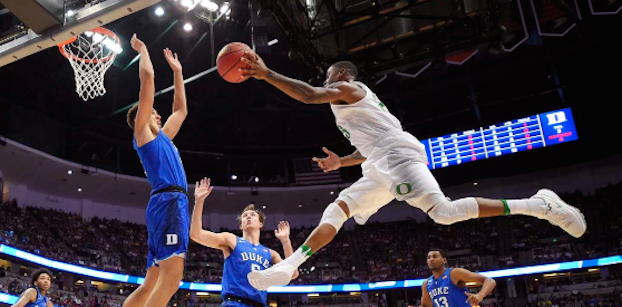As a freshman, Chase Jeter struggled to find minutes in Duke’s lineup.
The Las Vegas, Nev., product entered Duke as a highly regarded prospect — a consensus top-15 recruit. No one was expecting him to come in and be the heir apparent to Jahlil Okafor, but with Duke so thin along the front line, especially after Amile Jefferson was lost for the season, there were minutes up for grabs.
Jeter, however, was unable to carve out a niche.
The big man possesses the makings of a talented player: He’s long, bouncy and can run the floor. He has the body of the prototypical, modern-day center — a rim-runner who dives to the basket around spread pick-and-rolls and is a deterrent defensively (block rate of 3.3 percent last season.)
Duke’s coaches were careful with how they used Jeter a season ago. They didn’t want to overexpose him. Their offense also struggled with Jeter on the court.
According to Ken Pomeroy, Jeter posted the lowest offensive rating (97.2 points per 100 possessions) of anyone on the team, save for Derryck Thornton (96.7 points per 100 possessions). It’s easy to see, following Jefferson’s injury, that Duke’s best offensive lineup featured Grayson Allen, Brandon Ingram, Matt Jones, Luke Kennard and Marshall Plumlee. The numbers support that belief, too; none of those five players had an offensive rating below 112, per KenPom.
It’s tough to forecast what to expect from Jeter this season. The Blue Devils’ freshman class includes three players 6-10 or taller: Harry Giles, Marques Bolden and Javin DeLaurier.
Giles is currently sitting out while recovering from knee surgery, but he’s an all-world recruit. When he returns, he’ll be a fixture in Duke’s lineup.
Bolden has drawn rave reviews during the preseason; he’s going to command minutes and post touches. Giles and Bolden are one-and-done type talents, which combined with the return of Jefferson — now in his fifth season as a Blue Devil — has made Duke’s frontcourt more crowded. Minutes will be hard to come by for Jeter and DeLaurier.
When Mike Krzyzewski has had four big guys in his rotation over the last decade, there’s usually an imbalance of minutes. In 2014-15, Marshall Plumlee — playing behind Okafor, Amile Jefferson and Justise Winslow (small-ball four) — played just 375 minutes (9.6 per game). In 2013-14, Josh Hairston existed in this role; he played 284 total minutes (9.5 per game).
These calculations get tricky because Krzyzewski likes to eschew positions and play small. The 2015 title team hit a new level when Winslow became the team’s nominal four and stashed Jefferson to a bench role. In previous seasons, Coach K has used guys like Jabari Parker, Rodney Hood and Kyle Singler in similar hybrid-forward positions.
There’s a good chance that Krzyzewski deploys an athlete like freshman Jayson Tatum as a stretch-4 for pinches of time this season. When that happens, it will eat into the frontcourt minutes even more.
Right now, Duke has 80 minutes per game to split between what would be its two “big” positions. Once Giles returns to action, it’s hard to see Jeter carving out anything beyond spot duty in the rotation. If Jefferson, Giles and Bolden each average 25 minutes per game (a convenient round number for this hypothetical), that’s leaving only five minutes per night for a combination of Jeter, DeLaurier and whatever time Tatum or Jack White spend masquerading as power forwards. This is an embarrassment of riches for Krzyzewski, and ultimately a good problem to have. However, it may leave an intriguing player, like Jeter, on the outskirts of playing time.
One thing Jeter could do to help out his case: foul less frequently. In a marginal amount of playing time last season, he was one of the biggest culprits in the ACC. Jeter played 254 minutes and committed 59 personal fouls, which translates to an absurd 13.6 fouls per 100 possessions.
The freshman appeared in 32 games last season; in the first 16, he averaged 8.1 minutes, 1.8 points and shot 50 percent from the field. During the second half of the season, Jeter averaged 7.8 minutes, 2.1 points, 2.0 rebounds and shot 60 percent from the field. While his play improved, his time on the court mostly stayed flat.
Jeter did play at least 11 minutes in four of the team’s final 10 games. Can he make a case for more time as a sophomore? Only time will tell, but it seems unlikely. That said, he’s a gifted player, so there’s always a chance he could find ways to get more burn.

















